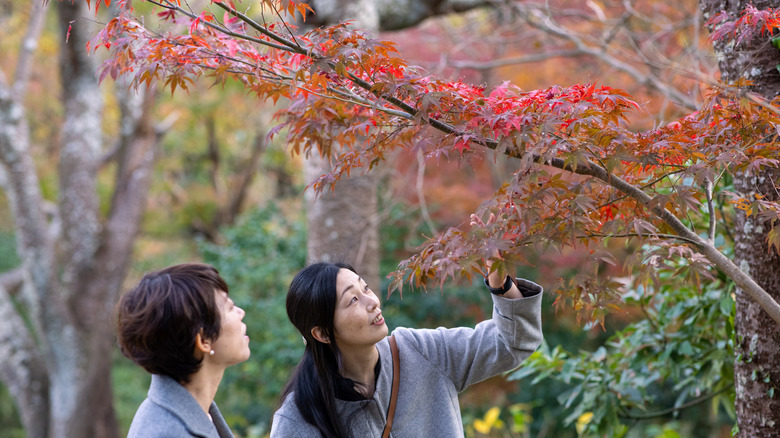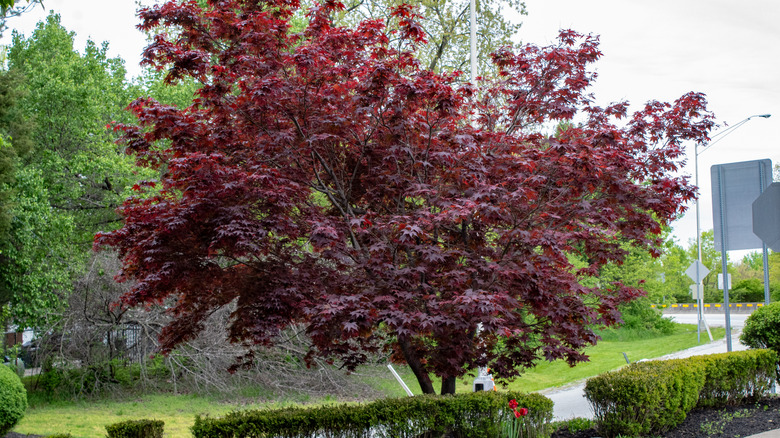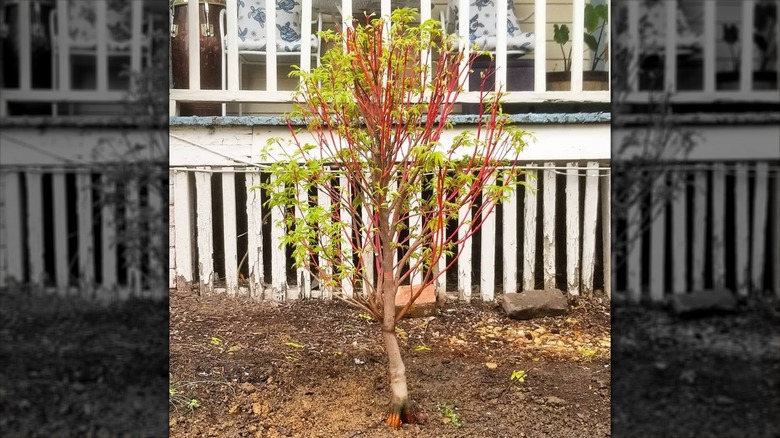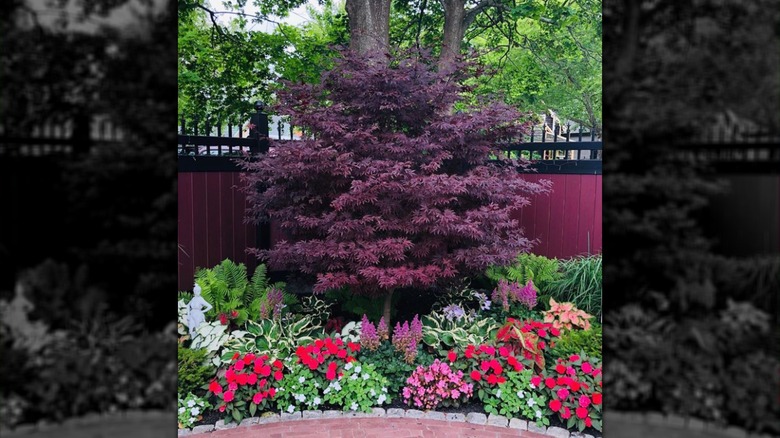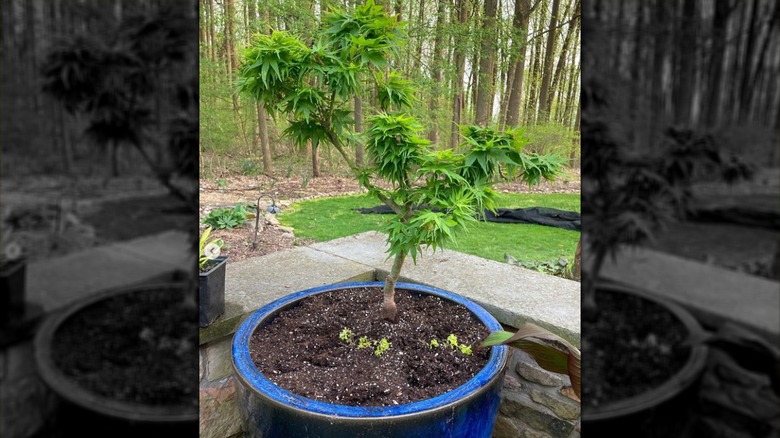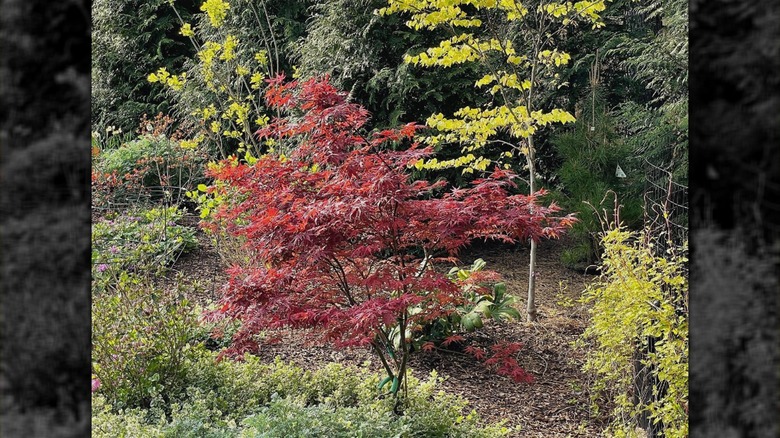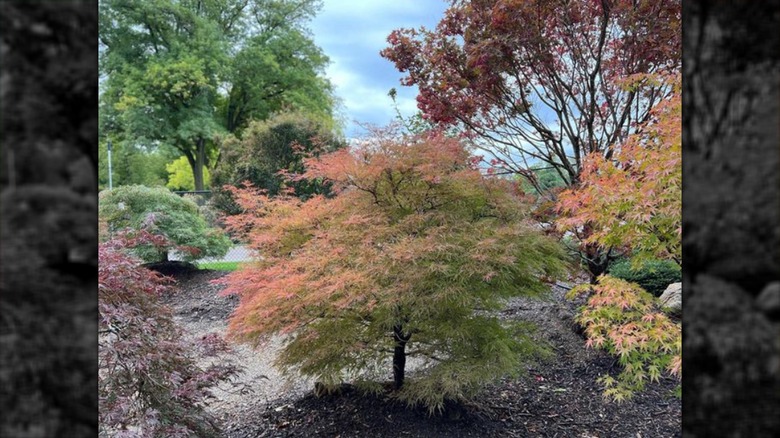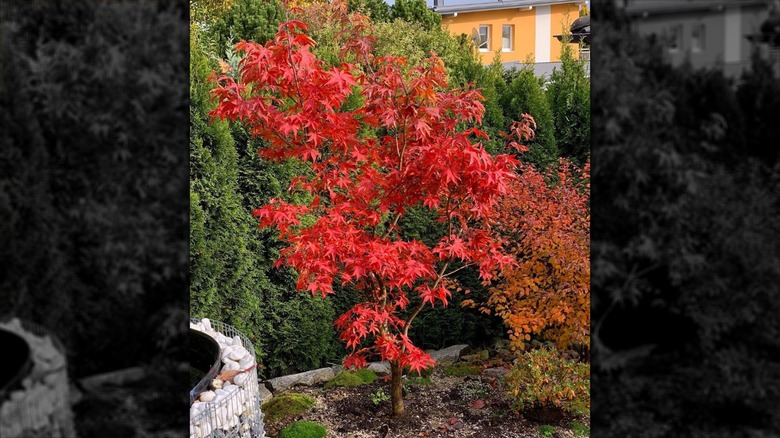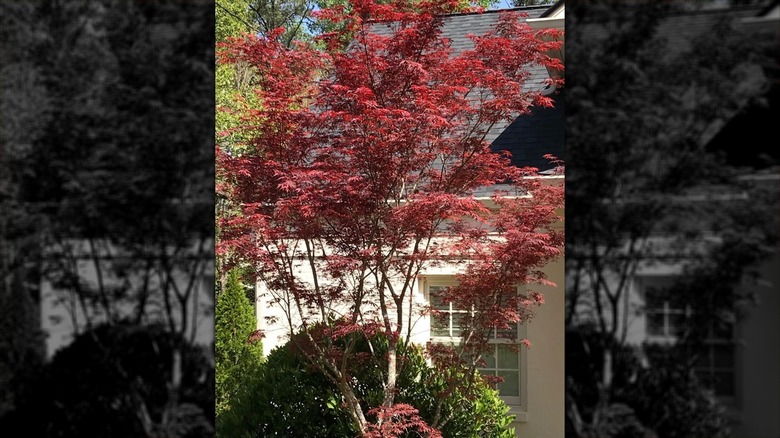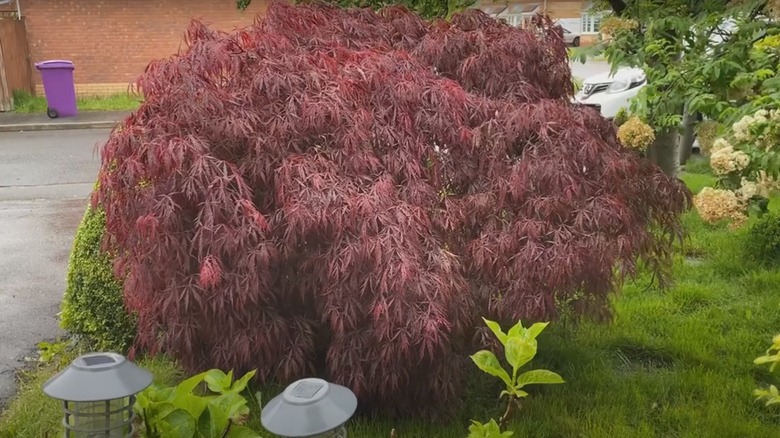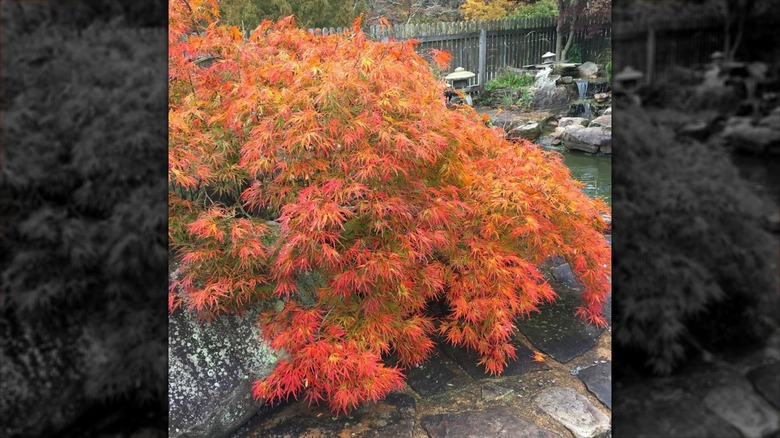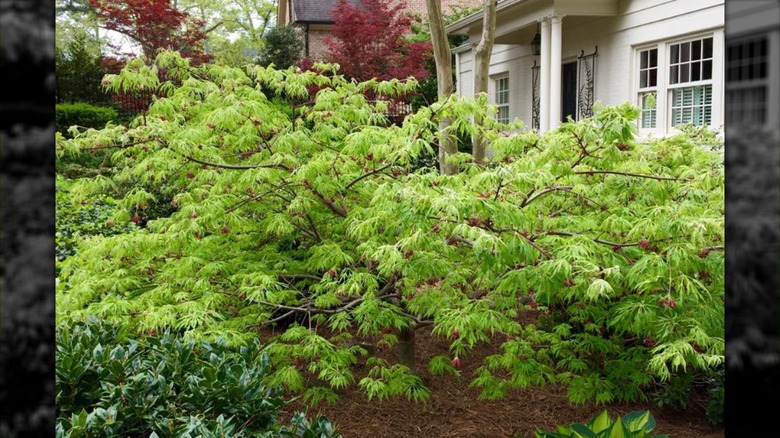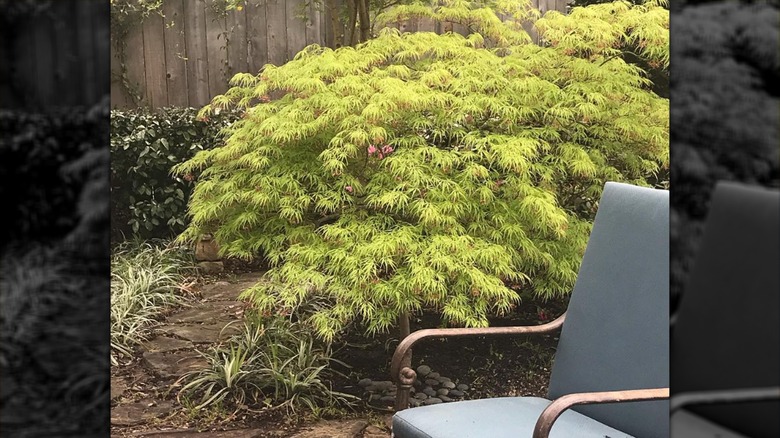12 Japanese Maple Tree Varieties That Will Bring Beauty To Your Yard
The Japanese maple is a common name referring to a species of trees or shrubs under the scientific name Acer palmatum. They can be found throughout Japan, China, and Korea, but are often imported to gardens around the world, admired for their beautiful, soft foliage and surprising fall leaf colors. Japanese maple trees are a beautiful choice to add to your garden, but there's more than one kind to choose from. While these trees are most recognizable from their rich red foliage, cultivars like 'Bloodgood,' 'Osakazuki,' and 'Waterfall' can differ slightly. With so many options for stunning maple trees that will add drama to your yard, you can think outside the box. Consider if you'd prefer a cascading, weeping, or upright growth style and what shades you'd like your leaves to be, from vibrant green to mellow gold, orange, and deep maroon in autumn.
Specific cultivars of Japanese maple don't just offer different appearances. Some are better suited for cool climates, warm climates, droughts, or shady spots. Here are 12 brilliant varieties of Japanese maple that you should know about, their growth pattern and foliage style, and the essential care facts that will help you decide which is right for your garden. Before you plant any, however, use caution as the plant may have invasive features in some areas of New York and throughout the Mid-Atlantic. However, it's not currently regulated and as long as you ensure your Japanese maple won't spread to native forests, it will likely be fine.
1. 'Bloodgood' Japanese maple
As its name might imply, the 'Bloodgood' Japanese maple cultivar is best known for its striking, deep red leaves. Purple leaves emerge in spring and fade into their ruby coloring as temperatures get warmer, then stay red throughout most of the summer and fall. 'Bloodgood' Japanese maple trees are the perfect addition to your summer landscape, but they're also quite tolerant of cold winter temperatures and can grow in USDA zones 5 through 9. The 'Bloodgood' has an upright, rounded shape and at full maturity will typically reach around 20 feet tall.
2. 'Sango-kaku' Japanese maple
'Sango-kaku' Japanese maple is a type of upright Japanese maple recognized by its unique reddish bark color, and is one of the best colorful plants to grow in your garden besides flowers. The leaves of this tree show a whole array of colors throughout the year, turning from green to gold, orange, and burgundy. The color will become more apparent after leaves fall in winter, especially if the tree is grown in full sun. 'Sango-kaku' will reach a maximum height of about 25 feet, and thrives in USDA zones 6 through 8.
3. 'Emperor I' Japanese maple
With a similar appearance to the 'Bloodgood' variety, 'Emperor I' also boasts deep red leaves and an upright, rounded crown. However, 'Emperor I' tends to bud later in spring, making it a better choice for areas where late frosts are common. The leaves of the 'Emperor I' Japanese maple will emerge in spring with a rich purple hue that fades to fiery crimson before dropping in fall. This tree will survive in USDA zones 5 through 8, and unlike some other maples, will happily grow in partial sun or even shade.
4. 'Mikawa yatsubusa' dwarf Japanese maple
If you're looking for a Japanese maple variety for a small backyard, a dwarf maple can add a splash of color without overcrowding your space. 'Mikawa yatsubusa' is a popular dwarf Japanese maple variety that usually stays below 6 feet tall and 8 feet wide and can survive in a good range of USDA zones 5 through 9. This variety doesn't have the typical red display of many other Japanese maples; spring leaves of the 'Mikawa yatsubusa' variety are a bright yellow-green which turns emerald in summer before going gold in fall.
5. 'Purple Ghost' Japanese maple
Another suitable option for small yards and warm climates is the 'Purple Ghost' Japanese maple. This upright variety boasts lavender or purple-red leaves in spring and summer which turn to deep crimson in fall, making it a good choice for unique year-round color in your garden. At full maturity, 'Purple Ghost' will reach around 10 feet tall with dense, upright branches. The 'Purple Ghost' Japanese maple will grow well in USDA zones 6 through 9, and prefers full sun or partial sun, although some dappled afternoon shade will help this plant develop its best purple hues.
6. 'Baldsmith' Japanese maple
The 'Baldsmith' is a variety of laceleaf Japanese maple, known for its dainty, feathery leaves and cascading branches. This tree grows somewhat slowly and in a wide, mounded formation before shooting up to 10 feet tall. With a gorgeous seasonal display, 'Baldsmith' will produce pinkish leaves in spring that become tinged with green in the summer and burst into bright scarlet in fall. Suited for USDA zones 5 through 9, this is one Japanese maple variety that can grow well in containers as long as it has excellent drainage.
7. 'Osakazuki' Japanese maple
For a fast-growing Japanese maple variety, look to 'Osakazuki'. This upright tree can reach a remarkable 20 feet tall in as little as 10 years, with a mature height up to 24 feet. 'Osakazuki' is well suited for gardens in USDA zones 5 through 9, but needs partial shade and thorough hydration to look its best. Ideal for gardeners who like to embrace all seasons in their garden, 'Osakazuki' will display bright yellow-green leaves in spring, which turn to more verdant green in summer before flashing vibrant red in fall.
8. 'Sherwood Flame' Japanese maple
For a red-leaf Japanese maple variety that makes a grand statement, the 'Sherwood Flame' cultivar is a brilliant and tall selection. This tree is quite a bit taller than most other red-leaf Japanese maple trees, reaching up to 16 feet tall and 14 feet wide. The leaves of this tree stay a stunning crimson throughout the seasons, but 'Sherwood Flame' also offers a unique display in winter, with samaras, also known as "maple keys" or "whirlybirds" that adorn the bare branches. 'Sherwood Flame' is ideal for USDA zones 5 through 8.
9. 'Tamukeyama' Japanese maple
'Tamukeyama' is a cascading laceleaf Japanese maple variety that may appear more like a shrub than a tree at first glance. 'Tamukeyama' reaches a maximum height around 6 to 8 feet tall when fully mature, but its branches can spread as far as 12 feet wide, forming a billowy dome-like shape. The 'Tamukeyama' Japanese maple will produce dense leaves that are purple-red in summer and bright crimson in fall. This variety prefers full or partial sunlight and can survive in USDA zones 5 through 8 — colder than some other varieties.
10. 'Waterfall' Japanese maple
Another cascading beauty, the 'Waterfall' Japanese maple forms a low, rounded canopy that can appear as if it's flowing over the edge of its container or garden bed. This variety sprouts soft, feathery leaves that float in the breeze, offering bright green foliage in spring that fades to gold and orange in fall. Perfect for USDA zones 5 through 8, 'Waterfall' can withstand full or partial sun in cool climates, but should receive protection from afternoon sun in hot areas. This tree will reach about 10 feet tall at most and up to 12 feet wide.
11. 'Green Cascade' Japanese maple
If you love the look and texture of a Japanese maple but prefer a more verdant look in summer, 'Green Cascade' Japanese maple could be the perfect variety for your garden. This shrub-like variety will only reach about 5 feet tall and 8 feet wide, making it good option for smaller yards and poolside gardens. This Japanese maple variety thrives in USDA zones 5 through 9 and holds its bright green color from spring through summer before bursting into a finale of gold, orange, and red in fall.
12. 'Viridis' Japanese maple
The 'Viridis' weeping Japanese maple is a large, cascading variety with a lovely wide-reaching canopy spread. This tree requires a patient gardener because it grows relatively slowly, but it can reach up to 8 feet tall and 10 feet wide when mature. Softy, wispy foliage surrounds this elegant tree, which displays bright green leaves in summer that fade to yellow and scarlet in fall. Appropriate for USDA zones 5 through 9, the weeping 'Viridis' is a good pick for raised beds and rock gardens where its "spilling" effect can be fully admired.
